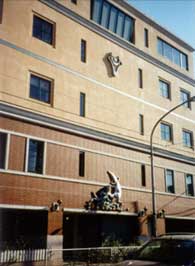|
Studio Pierrot wasn't a household name growing up in Japan. But as a child, their titles were part of my early youth, even when I moved to America at the age of six. Kids in the US probably grew up with Pierrot titles without even realizing their Japanese origins. "Mysterious Cities of Gold," a popular animated show that ran on television in the 80s, is the dubbed version of the company's early title "Taiyou no Ko, Esteban" ("Esteban, a Boy of the Sun").
But for over 20 years, Studio Pierrot has produced titles beloved by boys and girls alike, "Creamy Mami," "Urusei Yatsura," and "Kimagure Orange Road" to name a few. And the highly successful release of "Fushugi Yûgi" in North America through Pioneer Entertainment has increased the company's global visibility. On my last trip to Japan this past December, Akadot asked me to stop by Pierrot for a tour of their brand new facility, and a glimpse at what the future holds for them. While there I watched a video compilation of the opening and closing sequences from all of their titles. I realized then how many of them I had enjoyed as a child and how important a role Studio Pierrot played in my preschool days. I step off the JR train in the city of Mitaka, a beautiful suburb of Tokyo where rows of trees line the street, shading the brick-laid sidewalks. In the midst of this neighborhood, a five-story brick structure nestles between rows of apartment buildings and single family houses. A gold and silver clown sits in a crescent just above the front entrance. And near the top of the building, Studio Pierrot's familiar clown-face logo serves as the only indication that this is the home of one of the largest and most successful independent animation production studios in Japan. Pierrot moved into this building in 1999 after undergoing yet another expansion in its long history. Established 21 years ago, Studio Pierrot is the realized vision of Yuji Nunokawa who dreamed of starting his own company after leaving Tatsunoko Productions, where he worked on such series as "Yattahman" and "Time Bokan" as an animator and, eventually, a producer.
"As a child, I always liked the circus," Nunokawa told US fans at Anime Expo last July. "So when I named my company, I named it after the Japanese word for 'clowns.'" His adoration of clowns and love of things fantastical emblazon the walls of his office, which takes up a third of the Pierrot building's top floor. The first title Studio Pierrot animated was "The Wonderful Adventures of Nils" in 1979, a children's show that gleaned the attention of the Japanese Ministry of Welfare, which recognized it as the best children's show of the year. But the title that propelled Studio Pierrot into the big leagues is "Urusei Yatsura," Rumiko Takahashi's classic that started the careers of several anime legends such as Mamoru Oshii and Takada Akemi.* In the early 90s Pierrot produced their biggest hit to date, "Yu Yu Hakusho," which is based on a manga published in the popular "Weekly Shounen Jump." Emiko Iijima, director of international relations, and Ryuji Kaneko, head of internet development, agree to give me a tour of Pierrot's operations. Eager and overwhelmed with childhood nostalgia, I set out on my journey behind the scenes. |
||||||
|
* Takada Akemi prefers to have her name written in the Japanese style, with her surname first. |


